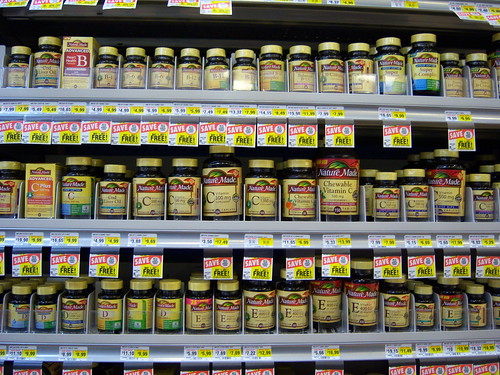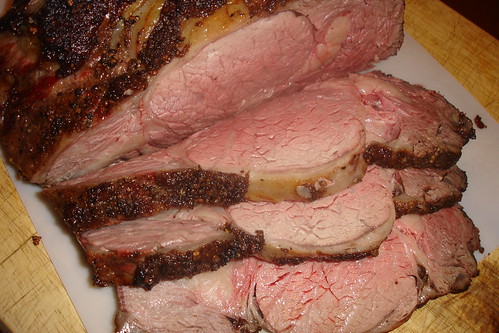We’ve been bombarded for years with the evils of trans fat…
…and for once, the mainstream advice appears to be mostly correct. Trans fats cause coronary heart disease, they’re strongly associated with obesity, depression, infertility in women, and breast cancer, and they interfere with critical liver enzymes. (More.)
I’ve written about trans fats before: if you want to learn their basic chemistry—and more importantly, how to avoid them when shopping for food—read my article Eat More “Heart-Healthy” Trans Fats! (We hid them in plain sight).
“Help! There’s Trans Fat In My Grass-Fed Beef!”
However, an alert commenter (Steven) pointed out that beef contains a significant amount of trans fat. And while his estimate was a bit high, it is absolutely true that one ounce of beef fat (28.3g) usually contains 0.5g-1.4g of trans fat.
In fact, the meat and milk of ruminants contains a significant amount of trans fat—roughly 2-5% of the total. Even worse, grass-fed milk and meat contains even more trans fat than grain-fed milk and meat!
Journal of Dairy Science
Volume 82, Issue 10 , Pages 2146-2156, October 1999
Conjugated Linoleic Acid Content of Milk from Cows Fed Different Diets
T.R. Dhiman, G.R. Anand, L.D. Satter, M.W. Pariza“Cows grazing pasture and receiving no supplemental feed had 500% more conjugated linoleic acid in milk fat than cows fed typical dairy diets.”
What’s going on here?
Trans-Vaccenic Acid and the Conjugated Linoleic Acids
No, I haven’t just named an obscure prog rock band from the 1970s. I’ve named the culprits: vaccenic acid and rumenic acid (a conjugated linoleic acid). Though vaccenic acid comprises most of the total, our bodies convert vaccenic acid directly to rumenic acid (just as they convert stearic acid directly to oleic acid), so nutritionally, we only need to investigate the effects of rumenic acid.
(This conversion is not reflected in American nutritional labeling—which requires stearic acid to be counted as saturated fat and vaccenic acid to be counted as trans fat, despite the fact that our bodies immediately convert them to different forms.)
A Short Biochemistry Excursion
Rumenic acid is known formally as (9Z,11E)-octadeca-9,11-dienoic acid, and informally as cis-9, trans-11 18:2. Vaccenic acid is known formally as (E)-Octadec-11-enoic acid, and informally as 18:1 trans-11.
Interestingly, the enzyme that converts vaccenic acid to rumenic acid—delta-9-desaturase—is the same enzyme that converts stearic acid (a saturated fat, 18:0) to oleic acid (a monounsaturated fat, 18:1 cis-9). That’s because delta-9-desaturase creates a cis-handed double bond at the 9th position. If you look at their informal names (or their chemical structure), you’ll see that the difference between vaccenic and rumenic acid is a cis-9 double bond, just the same as the difference between stearic and oleic acid is a cis-9 double bond.
Rumenic acid is part of a family of fats known as conjugated linoleic acids. “Conjugated” means that it contains both cis- and trans- bonds, just as its name (cis-9, trans-11 18:2) says.
Where Do The Trans Fats In Beef and Milk Come From?
Multicellular animals create only cis-handed fats with their enzymes…so where do trans-rumenic and trans-vaccenic acid come from?
Answer: they come from bacteria.
Cows, and other ruminants, can’t digest grass any more than we can. However, they have extra “stomachs” that are basically big microbial fermentation vats, in which bacteria digest the grass for them. (Whereupon they burp it up again, “chew the cud”, and finally swallow it into the regular digestive system once the rumen bacteria are done working.) Trans-rumenic and trans-vaccenic acid are created by these rumen bacteria via biohydrogenation of polyunsaturated fats (link).
When Trans Fats Are Good For You: Our Friend Rumenic Acid
As with most rules of thumb, “trans fats are bad” is an oversimplification. “Molecules found nowhere in real food are bad” is the correct statement. People have been eating ruminants for millions of years, so one might expect that our bodies might have a nutritional use for rumenic acid.
This is, in fact, the case. The health benefits of rumenic acid are well-established—to the point where conjugated linoleic acid supplements (usually labeled “CLA” in big letters) are found in every vitamin store!
Conjugated linoleic acids (CLA) are a group of positional and geometric isomers of linoleic acid with proven beneficial influence on health. They show e.g. anticarcinogenic, antiobesity, and antiatherogenic effect. Milk, dairy products and meat of poligastric animals are their most valuable dietary sources, with cis-9, trans-11 CLA (RA – rumenic acid) being the predominant isomer.
…
This group of fatty acids has been extensively studied for recent years, in both in vivo and in vitro models, because of their beneficial biological effects: protection against cancer [7-10], prevention of atherosclerosis [11-14], reduction of obesity [15-17] and hypertension [18].
–Bialek et.al.
Since vaccenic acid (which becomes rumenic acid) and rumenic acid comprise 2-5% of beef and milk fat, this gives us yet another excellent reason to consume fatty meat and butter. Sign me up!
CLA Supplements: Not The Same As Real Food
It’s easy to get trapped in “nutritionism”: the idea that we can eat whatever junk we want, and take supplements to replace the nutrients we’re not getting from our food. This rarely works…and in the case of CLA supplements, we know why.
Recall that “conjugated linoleic acid” can mean a whole host of different fats, depending on the positions of the double bonds. Most CLA supplements are derived from safflower oil—
—and they contain equal parts rumenic acid (cis-9, trans-11 18:2) and an unnamed trans-10, cis-12 18:2 isomer. In other words, half of a CLA supplement is an entirely different chemical than what you’re getting from meat and butter.
Unfortunately, trans-10, cis-12 doesn’t have all the same beneficial effects. While it still seems to have anti-cancer properties in mice, it doesn’t have the same effects on human metabolism as rumenic acid:
Circulation. 2002; 106: 1925-1929
Supplementation With Conjugated Linoleic Acid Causes Isomer-Dependent Oxidative Stress and Elevated C-Reactive Protein: A Potential Link to Fatty Acid-Induced Insulin Resistance
Ulf Risérus, MMed; Samar Basu, PhD; Stefan Jovinge, MD, PhD; Gunilla Nordin Fredrikson, PhD; Johan Ärnlöv, MD; Bengt Vessby, MD, PhD“The significant increase from baseline in 8-iso-PGF2α, 15-K-DH-PGF2α and CRP after t10c12 CLA was 1.04±0.7 (578%), 0.30±0.31 (77%), and 2.89±3.66 (110%), respectively.
…
This randomized, double-blind, placebo-controlled trial demonstrates that dietary supplementation with t10c12CLA causes isomer-specific oxidative stress that is related to induced insulin resistance.”Diabetes Care September 2002 vol. 25 no. 9 1516-1521
Treatment With Dietary trans10cis12 Conjugated Linoleic Acid Causes Isomer-Specific Insulin Resistance in Obese Men With the Metabolic Syndrome
Ulf Risérus, MMED1, Peter Arner, MD, PHD2, Kerstin Brismar, MD, PHD3 and Bengt Vessby, MD, PHD1“This randomized placebo-controlled trial has revealed unexpected metabolic actions by conjugated fatty acids in humans—actions that seem isomer-specific. The t10c12 CLA isomer, but not a CLA mixture, significantly increased insulin resistance, fasting glucose, and dyslipdemia in abdominally obese men.”
[I can’t resist an editorial comment at this point: why did neither study test rumenic acid alone, the way it occurs in real food? Might it have actually reduced oxidative stress and decreased insulin resistance, when not forced to fight equal amounts of the imposter t10c12?]
It’s important to note that many of the studies that claim benefits for t10c12 are on mice or rats. As Risérus et.al. note:
“Conjugated linoleic acid (CLA) is a group of dietary fatty acids with antiobesity and antidiabetic effects in some animals. The trans10cis12 (t10c12) CLA isomer seems to cause these effects, including improved insulin sensitivity.”
Unfortunately, as their experiment proved, the safflower-derived t10c12 doesn’t have the same benefits for humans as it does for rodents. And perhaps we shouldn’t be surprised that ingesting a chemically extracted fraction of a seed oil doesn’t produce the same benefit as eating real food.
Conclusion: Keep Eating Like a Predator, Keep Eating Real Food
Our conclusions should be obvious, but I’ll restate them:
- If we’ve eaten something for millions of years, the odds are very good that we’re adapted to eating it.
- Be skeptical of studies that feed fat to mice—herbivores that naturally subsist on plants and seeds.
- Whenever possible, eat real food, not supplements. You might not be getting the same benefits…or even the same nutrients.
- Most importantly: keep eating delicious fatty red meat and butter!
Live in freedom, live in beauty.
JS
Share this article with the buttons below, check out the index for more useful and entertaining information…and check the right sidebar (scroll up) for ways you can support gnolls.org!




